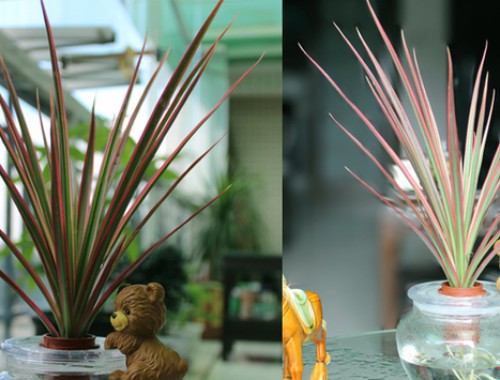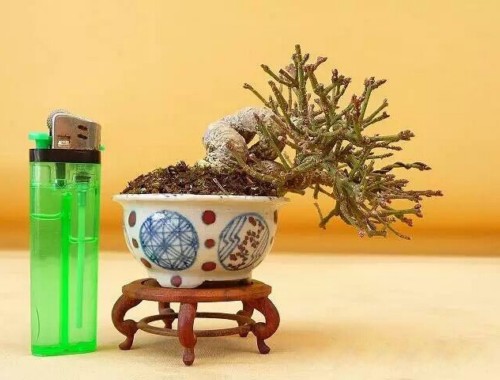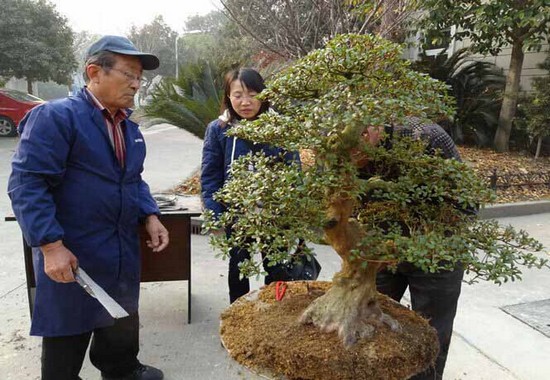Formaldehyde bonsai in the bedroom
The bedroom is a place for people to sleep and rest, and it is appropriate to create a beautiful and quiet atmosphere. Large flowers cannot be put in the bedroom, although plants produce oxygen, but they absorb oxygen without photosynthesis at night, which is bad for people's health, and cannot raise flowers with fragrance, which stimulates nerves and affects sleep quality. if you have to raise, put small potted plants, such as thousand-year-old wood, ivy, white palm, gondola, non-toxic, are experts in purifying the air.

1. Millennium wood
As long as you pay a little attention to it, it can grow for a long time and bring good air. It is difficult for other plants to compare with millennium wood in terms of inhibiting harmful substances. Leaves and roots can absorb xylene, toluene, trichloroethylene, benzene and formaldehyde, and decompose them into non-toxic substances. Light conditions: neutral plants, suitable for planting in semi-shade
Required maintenance: keep the basin soil moist and fertilize regularly
Can be removed: toluene, xylene, benzene, trichloroethylene, formaldehyde
2. Hanging orchid
The hanging orchid that is placed in the bathroom, windowsill or shelf is very eye-catching, its slender and graceful branches and leaves can effectively absorb formaldehyde released by curtains and fully purify the air. The hanging orchid naturally drooping branches and leaves are very beautiful, when the branches are luxuriant, it will occasionally turn slightly. And it's not complicated to take care of it.
Light conditions: neutral plants
Required maintenance: keep the basin soil moist
Can be removed: formaldehyde
3. White palm
White palm is an "expert" who suppresses exhaust gases exhaled by the body, such as ammonia and acetone. It can also filter benzene, trichloroethylene and formaldehyde in the air. Its high evaporation rate can prevent dryness of nasal mucosa and greatly reduce the possibility of disease.
Light conditions: shade-loving plants, suitable for warm, shady and humid environment
Required maintenance: keep the basin soil moist and fertilize regularly, and the leaves need to be sprayed frequently.
Can be removed: ammonia, acetone, benzene, trichloroethylene, formaldehyde
4. Ivy
Ivy can effectively resist the carcinogens in nicotine. Through the tiny pores in the leaves, ivy can absorb harmful substances and convert them into harmless sugars and amino acids.
Light conditions: neutral plants, suitable for planting in semi-shade
Required maintenance: keep the basin soil moist and fertilize regularly
Can be removed: formaldehyde, nicotine
Most of the decoration materials and furniture materials on the market inevitably contain formaldehyde, and formaldehyde is very harmful to human health, which can induce nasal cavity cancer, nasopharyngeal cancer and nasal sinus cancer, and can cause leukemia. Formaldehyde has become an important source of indoor air pollution, and it is a very popular method to put plants in newly decorated houses to absorb formaldehyde. Today, I would like to tell you which plants are formaldehyde nemesis?
Formaldehyde nemesis one: aloe vera
Aloe is a kind of succulent plant, which is suitable for growing in a warm and dry environment. Aloe is very powerful in absorbing formaldehyde and has strong medicinal value, such as facial beauty with aloe juice. In addition, aloe is also ornamental and can be used to decorate the bedroom.
Formaldehyde nemesis II: Tiger tail orchid
Tiger tail orchid is a common family potted variety, resistant to drought, like sunshine and warmth, but also resistant to shade and avoid waterlogging. It can absorb more than 80% of indoor harmful gases and has a strong ability to absorb formaldehyde.
Formaldehyde nemesis III: green pineapple
Green pineapple is a large evergreen vine, which has a strong ability to purify the air like the plants of Cymbidium and Ivy. Green pineapple can absorb de benzene, trichloroethylene, formaldehyde and so on in the air, and it is most suitable for the newly decorated new house to put green pineapple. According to environmentalists, a pot of green apple is equivalent to an air purifier in a room of 8 square meters. It can be seen that the air purification ability of green pineapple is quite strong.
Formaldehyde nemesis IV: Ivy
Ivy is a typical negative plant that grows well in warm and humid climates and is not hardy. It can effectively remove formaldehyde and benzene. Can break down two harmful substances, namely formaldehyde in carpets, insulating materials, plywood and xylene, which is harmful to the kidneys hidden in wallpaper.
The above four kinds of formaldehyde nemesis plants are very effective in removing formaldehyde. After the house is decorated, you can go to the flower market to buy these plants indoors, and open the doors and windows for ventilation, the effect will be better.
Time: 2019-05-23 Click:
- Prev

Advantages and disadvantages of bonsai planted in purple sand basin and porcelain basin
Most potted people think that purple sand basin is more suitable for growing bonsai than porcelain basin, because the wall of purple sand basin is permeable, which is beneficial to the growth and development of root system, plant grows well and root retting can be avoided. This is not the case with porcelain pots. Even if they use porcelain pots to plant plants, they also make a fuss on the inner wall of the pots.
- Next

An attempt not to change the soil of bonsai
According to the traditional concept, bonsai should be changed every two or three or four or five years. This heavy work cost us a lot of manpower, material resources and time. Especially for large-scale production and collection units, changing pots has become a big burden. At first, I also changed the soil every three or four years, tired and troublesome at the same time.
Related
- Fuxing push coffee new agricultural production and marketing class: lack of small-scale processing plants
- Jujube rice field leisure farm deep ploughing Yilan for five years to create a space for organic food and play
- Nongyu Farm-A trial of organic papaya for brave women with advanced technology
- Four points for attention in the prevention and control of diseases and insect pests of edible fungi
- How to add nutrient solution to Edible Fungi
- Is there any good way to control edible fungus mites?
- Open Inoculation Technology of Edible Fungi
- Is there any clever way to use fertilizer for edible fungus in winter?
- What agents are used to kill the pathogens of edible fungi in the mushroom shed?
- Rapid drying of Edible Fungi

